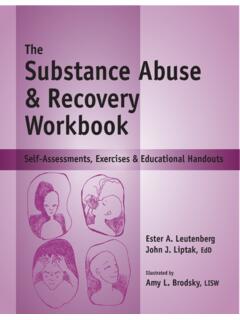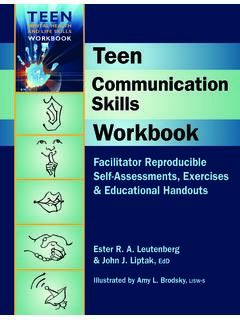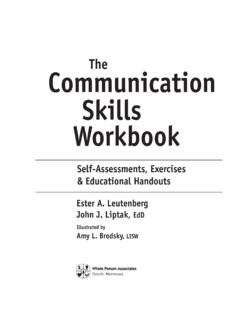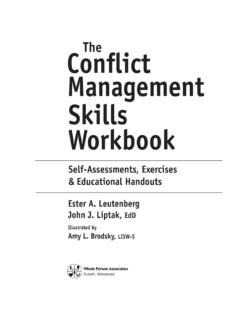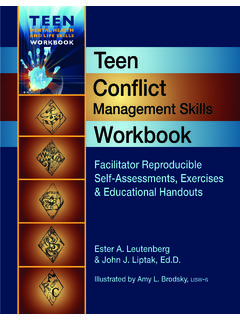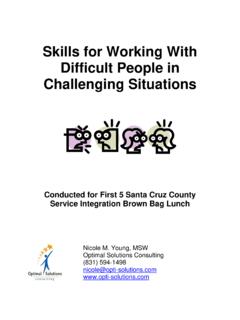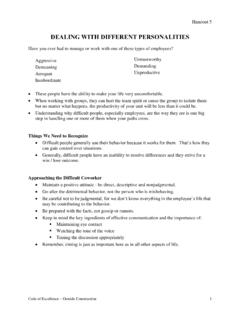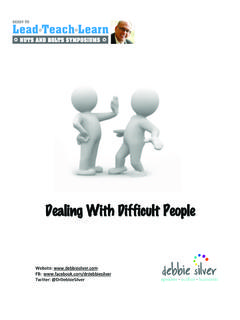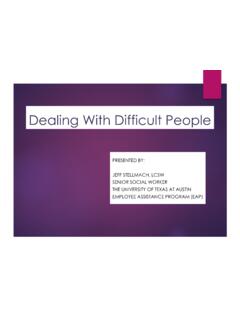Transcription of Coping with Difficult People Introduction …
1 I 2012 Whole Person AssociAtes, 210 West MichigAn st., Duluth Mn 55802-1908 800-247-6789 Coping with Difficult People IntroductionFacilitator Reproducible Guided Self-Exploration Activities Ester A. Leutenberg & John J. Liptak, Illustrated by Amy L. Brodsky, l i s w-swithworkbookCopingDifficult Peopleii 2012 Whole Person AssociAtes, 210 West MichigAn st., Duluth Mn 55802-1908 800-247-6789 Coping with Difficult People IntroductionWhole Person 210 West Michigan Street Duluth, MN with Difficult People Workbook Facilitator Reproducible Guided Self-Exploration ActivitiesCopyright 2012 by Ester A. Leutenberg and John J. Liptak. All rights reserved. Except for short excerpts for review purposes and materials in the assessment, journaling activities, and educational handouts sections, no part of this book may be reproduced or transmitted in any form by any means, electronic or mechanical without permission in writing from the publisher. Self-assessments, exercises, and educational handouts are meant to be efforts have been made to ensure accuracy of the information contained in this book as of the date published.
2 The author(s) and the publisher expressly disclaim responsibility for any adverse effects arising from the use or application of the information contained herein. Printed in the United States of America10 9 8 7 6 5 4 3 2 1 Editorial Director: Carlene Sippola Art Director: Joy Morgan Deylibrary of congress control number: 2011938513 isBn: 978-1-57025-260-0iii 2012 Whole Person AssociAtes, 210 West MichigAn st., Duluth Mn 55802-1908 800-247-6789 Coping with Difficult People IntroductionUsing This BookDifficult People are everywhere. Difficult People are those who frustrate us to no end. (In fact, others may view each of us as a Difficult person.) We encounter Difficult People at home, in the workplace, school, grocery market, anywhere. Often how much they affect us depends on our self-esteem, ability to recognize hot buttons and effectiveness of communication one meets many different varieties of Difficult People , we have suggested six types that seem to be the most common.
3 These Difficult People will have some or all of the following traits:WHINERS are People who find fault in others and everything they do, blame others for what happens in their lives, and know for certain what should be done but rarely work to improve or correct a situation. They whine in a high-pitched tone, cry and grumble to complain about problems rather than working to fix them or find solutions for them. They are often able to see problems that need solutions, but choose to complain the problems rather than working to solve are People who think that they know more than everyone else. They believe they have more knowledge and expertise and have all of the answers, and they know they are always right. They do not like to be corrected and will often be impatient, defensive, defiant and sarcastic with People who disagree with them, or they shut down or argue without reason. They feel they are experts on all subjects, behave arrogantly and take exception to anything said to People are often angry, impatient and explosive.
4 They use strength, coercion, force and power to make their point. They often intimidate others into agreeing with them or giving up their point of view. They are critical of People who do not agree with them, and they use ridicule, belligerence, accusations, and verbal, emotional and/or physical abuse as a way of putting People down. People who interact with them feel a need to be cautious (as if they are walking on eggshells.)PASSIVE People are hard to understand and hard to get to know. They are usually shy, quiet and reserved; they simply want to blend in and not be noticed. They rarely share their opinions or assert themselves to get their views across. They do not talk or share a lot and do not feel the need to respond to questions, especially personal ones. They often appear aloof and detached. NEGATIVE People are usually pessimistic People who will always say such things as that will never work and we have tried that in the past. They are skeptical that anything will turn out right or be right.
5 They drag others down and make everyone s environment as negative and as pessimistic as they are. They are unable to see the positive in anything and will always believe that things will not work out. YES- People are super pleasant and agreeable. They usually promise something that they cannot deliver. They seek approval and are afraid to say no to other People , especially the important People in their lives. They say what People want to hear and will agree with each person s opposing views or opinions. The next section provides a model for your participants to use when they find themselves dealing with Difficult People . This model will provide structure for the four chapters that follow. iv 2012 Whole Person AssociAtes, 210 West MichigAn st., Duluth Mn 55802-1908 800-247-6789 Coping with Difficult People IntroductionInformation about Dealing with Difficult PeopleBecause participants will encounter Difficult People in all aspects of their lives, it is important for them to learn a way of dealing with them.
6 In this book, Coping with Difficult People Workbook, we teach a specific model that participants can use to build positive relationships with Difficult this model, participants can deal effectively with Difficult People in their lives by following a few critical steps including:1) Identify the person s personality type and what makes the person so Difficult for others to ) Learn and utilize critical communication and listening skills to build a positive ) Cope effectively with the ) Learn skills to respond effectively and/or to confront the ) IdentIfy the person s personalIty type4) respond and / or confront the person3) cope effectIvely with the person2) communIcate effectIvelyv 2012 Whole Person AssociAtes, 210 West MichigAn st., Duluth Mn 55802-1908 800-247-6789 Coping with Difficult People IntroductionInformation for the ParticipantsDifficult People are all around you. They seem Difficult to you because they possess a different personality type than yours. This does not make them bad People , simply different and Difficult for you to handle.
7 The personality style of one of your Difficult People may bother other People too; or it may not bother other People . Often the problem is the person, and often the problem is not necessarily the person, but rather how one perceives the person or how the person behaves and responds. Perception is your understanding of how things ought to be. The Coping with Difficult People Workbook will help you to better understand People with whom you have difficulty, and give you tools and techniques for looking beyond the traits and characteristics that make the person Difficult for you. You will also have the opportunity to look at what is being triggered in you that makes the person seem so Difficult . Facilitators can help their participants by reminding them of the following facts: 1. Encountering Difficult People is a part of life. It is important to be able to cope with and manage or adapt to Difficult People When dealing with Difficult People , there is a process for managing your interactions.
8 The assessments, activities, and exercises contained in this workbook will help you to learn to deal effectively with Difficult People . 3. If you ignore a Difficult person, things will get worse. You will begin to experience stress and your emotions will eventually erupt. By completing the activities and exercises included in this workbook, you will be able to not only deal with a Difficult person, but you will have developed a process that you can use in any situation with any type of When you are able to face Difficult People and resolve problems yourself, you will begin to feel more self-confident. You will feel more in control of your life. The secret is to have a plan of action that consists of tools and techniques for confronting and dealing effectively with Difficult Using the Tools in This Workbook: You may be asking yourself: Why do I need to deal with Difficult People ? Here are some reasons: Difficult People will present themselves in all aspects of your life at home, in the workplace, at school, in the neighborhood or community, etc.
9 Assertive confrontation is challenging, but it is a skill that can be learned and improved with practice. The ability to deal effectively with Difficult People will greatly improve the quality of your life. Inability to cope with Difficult People will lead to resentment, anger, frustration and misunderstanding. Interacting with Difficult People while you are angry will only make the situation worse. vi 2012 Whole Person AssociAtes, 210 West MichigAn st., Duluth Mn 55802-1908 800-247-6789 Coping with Difficult People IntroductionFormat of the BookThe Coping with Difficult People Workbook contains assessments and guided self-exploration activities that can be used with a variety of populations to help participants learn to cope more effectively with Difficult People . Each chapter of this workbook begins with an annotated Table of Contents with notes and examples for the facilitator. Each chapter contains two primary elements: 1) A set of assessments to help participants gather information about themselves in a focused situation, and 2) a set of guided self-exploration activities to help participants process information and learn effective ways of Coping with the Difficult People they encounter.
10 AssessmentsEach chapter begins an assessment that provides participants with valuable information about themselves. These assessments can teach recognition of effective and ineffective patterns of behavior, identify life skills which are productive and unproductive, and enrich your participant s understanding of how they interact with the world. Assessments provide a path to self-discovery through the exploration of personal unique traits and behaviors. The purpose of these assessments is not to pigeon-hole People , but to allow them to explore various elements that are critical for Coping with Difficult People . This book contains self-assessments and not tests. Traditional tests measure knowledge or right or wrong responses. For the assessments provided in this book, remind participants that there are no right or wrong answers. These assessments ask only for opinions or attitudes about topics related to a variety of Coping skills and assessments in this book are based on self-reported data.

